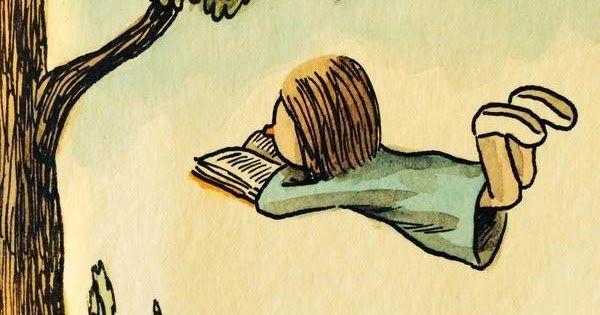ADSactly Education: Creative reading and writing

Creative reading and writing

When we read a good text, be it poetic, narrative or essay, regularly, it inspires us to write. Sometimes we do it in response to those texts; other times, as a continuation of them; but in many cases, an admiration for the author is born in us and hence the desire to reproduce his style. This type of scriptural enthusiasm is what we teachers usually try to provoke and channel in classrooms.

A research work, whether it be a thesis, a paper, a monograph, is a text that responds to the curiosity that a book can arouse in the reader. It is also the realization of creative texts, which although it is true can be created as a response to the experiential world of each person, they can also be the result of reading other texts. Although in the classroom we generally try to get students to approach writing in an objective and formal way, we also try to promote creativity, subjectivity and imagination, so making creative texts is always a good idea.
It can be a bit difficult to get students to write from their private and intimate world, so I usually bring them poetic, narrative or essay texts from other authors that provoke discussion and imagination. The idea is for students to do scriptural exercises where they can put into practice their creativity and what in one way or another is inside them.

One of the most used techniques is that of versioning stories. This practice can be interesting and productive, especially if we work with texts that are well known to students, such as fairy tales. The idea is to take something from the primary text that we are going to version and build a new text. That which we take may be the argument of the story, but also some symbol present and inherent to it. For example, from Little Red Riding Hood we can use the idea of the disobedient girl who encounters a ferocious animal, but we can also make another text from the red hood, the hungry wolf, the woodcutter and even grandmother. Let's see two examples of two great writers versioning Sleeping Beauty and Snow White and the 7 Dwarfs:
Once upon a time
A handsome young man knocks on the door and asks him to put on the most beautiful of slippers. As soon as he sees that it fits the foot perfectly, he grasps the arm at the same time as he tells him:
You are arrested, this slipper was found at the scene of the crime.
(Javier Quiroga G.)
Opus 8
Swear to us that if he wakes up, he won't take her away," one of the dwarfs asked the prince on his knees, as he contemplated the beautiful body in the crystal sarcophagus. Look, since he fell asleep, we have no one to wash our clothes, iron them, clean our house and cook for us.
(Armando José Sequera)

There are many texts that make us want to write, to say what they say, but in our way and from our experience. Much of the literature we read is induced by more literature. There is an exercise that we can do by imitation. The idea is to try to make a similar text, trying to change words or ideas, substantially imitating the structure and idea of the text. In order not to always fall into the stories, this type of exercise can also be done with poems. One poem we can use is Inventory of my only possessions by Jorge Carrera Andrades. I leave you a part of that poem here:
The cloud where the future vegetable beats,
the blank sheets spread by the dovecote,
the sun that covers my skin with its golden ants,
the ideography of a pumpkin painted by blacks,
the wild beasts of the unexplored wind forests,
the oysters with their tongue stuck to the palate,
the plane that drops its mushrooms into the sky,
insects like little flying guitars,
the woman suddenly seen as a landscape illuminated by a
lightning...
Before we continue, we must remember that there is a reason why they say there are no original works. Texts in literature are the same story: the original books were written a long time ago. In the case of the previous poem, the idea is that each person can make, like the poet Jorge Carrera Andrades, a poem that lists their belongings, those that are exclusive, that belong to them and that nobody can take from us.

To conclude, I would like to point out another interesting way to create texts from others and that is to finish the stories. Generally, we hear many stories in which the endings are not as interesting as we thought or do not end as we had imagined. With this type of exercise we give the story the ending we imagine or like the most. Unlike previous exercises, the writer must not know the story so that he can, from his creativity, build an end to it. Let's look at this story by the Argentine writer Enrique Anderson Imbert:
WINGS
I used to practice medicine in Humahuaca. One afternoon they brought me a child with no words: he had fallen over the precipice of a hill. When I took off his poncho to check it, I saw two wings. I examined them: they were healthy. As soon as the boy could speak, I asked him: _Why didn't you fly, m´hijo, feeling like you fell?
This story is inconclusive. The idea is that people can finish it according to what they think the child responded to the doctor. If they realize it, the idea is for people to follow the narrative thread of the story and give it the most interesting ending they can imagine. Just like this text, there are an infinite number of stories that since we started reading, we are imagining an end. This exercise not only helps to promote creativity but also manages to change those endings that we dislike.

We cannot teach to create, to be creative. We can only help, orient, stimulate. Creativity cannot be implanted, but it is exercised. Writing is part not only of what we have lived, but also of what we have read. If we can feel what we read and the reading awakens in us not only a sentimental but also a scriptural response, then let's not let that impulse pass, and write.
I hope this post has been useful. Remember to vote for @adsactly as a witness and join our server in discord.

BIBLIOGRAPHIC REFERENCE
Hugo Niño (2002). Palabrario. Open Classroom: Colombia.
Luisa Juanatey (1998). Aproximaciones a los textos narrativos en el aula (II). Arcolibros: Madrid.
Darío Jaramillo Agudelo (1997). Poemaquina. Pan-American: Bogotá.
Written by: @nancybriti
Click on the coin to join our Discord Chat

Witness proposal is here:
Go To Steem Witness Page
In the bottom of the page type: adsactly-witness and press vote.

Use small letters and no "@" sign. Or, click here to vote directly!
Thank you!
To assume the practice of creative writing from the exercise of a creative reading is a very productive method in the learning and development of the communicative competences of students and other individuals. Literary texts, especially poems and short stories, are ideal for this purpose. The exercises you propose are very practical and can give surprising and quality results.
However, it could also apply to other texts whose function is not aesthetic and transform them into that function. It could be done with advertisements, news of events, graffiti, etc. A very pleasant, motivating and proactive post, @nancybriti.
I'm glad you find it useful, @josemalavem. Creative writing can be difficult if we don't have the practice. With this post I wanted to give some simple ideas that could be put into practice to develop poetic exercises, narratives. To see writing as something natural and rewarding. Thank you for your comment!
As always, a well-worked, well illustrated and very interesting publication!
Motivating to read and thus stimulating creative writing is one of the practices that every teacher must carry out with determination and dedication. The proposals you share with us are very good, @nancybriti.
Thanks to @adsactly for spreading it.
These exercises can be interesting and productive in classes or workshops with upper-level students who are inclined to creative writing. They can come out beautiful and original texts. Thank you for commenting.
@adsactly
It's educational and you can learn a lot from what you post. All of your posts I like very much give such kind of information, thank you very much
I'm glad you liked them. Thank you for commenting.
deleted
Anything serves to inspire creative writing, from a poem, a stone, a scent, a look. Just be sensitive to the world!
This is one of my favorite posts. Quite often reading fills my mind with ideas, not necessarily a direct response but still an idea born from that reading. That exercise of rewriting stories endings is quite interesting I must say, although I prefer spin offs kind of stories. Excellent material. Thanks for sharing these exercises with us.